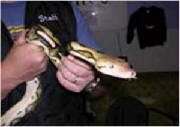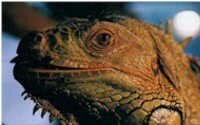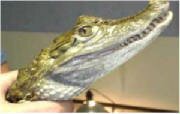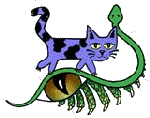|
|
 |
Special needs cats are the main focus of our shelter, but they are not the only animals we try to help. We also take in various "exotic reptiles" who need a home. Many of these animals end up with us because people get them as cute little babies and then find they aren't as much fun to have around when they reach adulthood. Some of our reptiles may be available for adoption --
please contact us for more information.
Reptiles at Witty Kitties
|
SNAKES
|
LIZARDS
|
CROCS
|
TURTLES
|
Sand Boa
Burmese Python
Reticulated Python
African Rock Python
Ball Python
Carpet Python
Anaconda
Corn Snake
Mole Snake
Florida Kingsnake
Albino Garter Snake
Boa Constrictor
|
|
American Alligator
Spectacled Caiman
|
Red-Footed Tortoise
Box Turtle
|
|
 |
|

About snakes...
1. What snakes are hardest to keep as pets?
- Wild-caught snakes often do poorly in captivity, won’t eat, and are prone to disease.
- Water snakes, boas, anacondas, and pythons have very precise requirements for their environment.
- Some snakes, especially large snakes, are dangerous. Boas (tree boas or "pythons," red-tailed boas or "boa constrictors"), anacondas, reticulated pythons, and Burmese pythons take special care and caution because of the threat they pose to humans and other pets.
2. What do pet snakes eat?
- Snakes eat pre-killed small animals. Some snakes will eat only live animals. You can buy pre-killed rodents (such as mice) or live animals, at pet shops.
3. Why can big snakes be dangerous?
- Snakes cannot be tamed or domesticated, like a dog or a cat. They remain wild animals.
- You can never leave a child alone with a large snake like a python, boa, or anaconda. Small children can, and have been, killed by such “pet” snakes.
- Snakes, including smaller snakes, can bite and -- even if not poisonous -- can hurt a person, child or adult.
- For all these reasons, and also for the safety of your snake, you shouldn't allow it to roam free in your home. This is true for other reptiles and amphibians as well.
4. Bigger snakes aren’t really dangerous to adults, are they?
- Yes, they are. Experienced animal handlers recommend that you have one assistant with you for every 5 feet of snake. One strong assistant.
5. How can I tell how big a snake will get?
- The only way to estimate the size of an adult snake is to learn all about that species before you decide to take one home.
- Don’t get a pet snake on impulse. Some snakes that are very small when young can quickly become very, very big. Do your homework.
6. Are there places that will take my snake if I can’t keep it any more?
- It is really hard to find a place for an adult snake, especially a large one. Zoos usually have all the snakes they want. Pet stores prefer baby snakes. Again, do your homework before you bring that neat critter home, because once you do, it will likely be your responsibility for as long as it lives.

About other reptiles...
1. Do lizards and other reptiles make good pets?
- Some of the smaller lizards, like the anoles, are easy to keep as pets.
- Larger reptiles can be aggressive or have a painful bite.
- Like some lizards, iguana and geckos must have live food.
- A number of reptiles (and amphibians as well) carry salmonella, a bacteria that can infect humans. Salmonella can be a threat to babies and very young children, to children and adults with immune system disorders, and to people who are elderly.
2. What’s wrong with just letting my pet reptile go when I don’t want it anymore?
After all, it is a wild animal.
- Tropical snakes (and that includes many of those sold as pets) won’t survive the cold winters of the upper Midwest. Neither will any of the crocs, caiman, or gators. Many of the lizards and other reptiles will also suffer and perish in our cold weather.
- Before these animals die of exposure, they may hurt people or other pets.
- If you absolutely can’t find a home by talking to other pet owners like yourself, contact an animal shelter for help. Be warned, however, that they may be able to offer no other solution than euthanizing the animal.
3. Can anyone own a snake, reptile, or amphibian?
- No. In many states it is illegal to own certain snakes, as well as other reptiles and amphibians.
- Talk with your local veterinarian, animal shelter, or wildlife officer about your state’s laws. (In some states it is also illegal to feed live prey.)

About alligators, caimans, and crocodiles...
1. Do alligators and caimans make good pets?
- Crocodilians -- alligators, crocodiles, and caimans (a small South American relative of the alligator) -- aren’t the pet for you if you want something that is friendly, responsive, and good-natured.
- Alligators get to be about 12-14’ long. Caimans are half this size – about as long as a man is tall. In other words, both are large predators.
- To an adult gator or caiman, humans look like lunch. This is true even with an animal that you have known, and handled, for many years. The feeding instinct is very, very strong.
2. Can I keep my caiman or gator in an old bathtub?
- The enclosure needs to be two or three times longer than the critter. As your caiman or gator grows, it will need a larger enclosure.
- You will need to be able to move around inside the enclosure to clean it. Most of the space inside the enclosure – about 75% of it – needs to be water. Clean water.
- Your pet will also need to have an area of dry land that it can always get to easily.
3. Will a croc, gator, or caiman stay small if you keep it in a small enclosure?
- Sure it will, just like a baby would stay "small" if you kept it enclosed in a tiny cradle. But it will suffer from deformity, pain, and poor health. So will a crocodilian imprisoned in a small space.
4. What do caimans and gators eat?
- Young caimans or gators eat insects (pesticide-free) or ground meat. Adults can eat small mammals, fish, or commercial alligator feed.
- Feeding is a dangerous time with growing crocodilians. These critters can run very fast for short distances. They can jump, too. They may mistake your hand for part of their meal, so using tongs or laying food on the ground and then letting the animal into the area is a good idea.
- It is important to be really careful during feeding times so that you aren’t treated like a tidbit yourself.
5. Do crocodiles make good pets?
- Crocodiles are less predictable and more aggressive than either gators or caiman. For those reasons, they aren’t ideal pets.
|
 |
|
 |
|
 |
|
|
|
Copyright 2019, Witty Kitties, Inc.
|
|
|
 |

